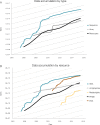The European Bioinformatics Institute in 2016: Data growth and integration
- PMID: 26673705
- PMCID: PMC4702932
- DOI: 10.1093/nar/gkv1352
The European Bioinformatics Institute in 2016: Data growth and integration
Abstract
New technologies are revolutionising biological research and its applications by making it easier and cheaper to generate ever-greater volumes and types of data. In response, the services and infrastructure of the European Bioinformatics Institute (EMBL-EBI, www.ebi.ac.uk) are continually expanding: total disk capacity increases significantly every year to keep pace with demand (75 petabytes as of December 2015), and interoperability between resources remains a strategic priority. Since 2014 we have launched two new resources: the European Variation Archive for genetic variation data and EMPIAR for two-dimensional electron microscopy data, as well as a Resource Description Framework platform. We also launched the Embassy Cloud service, which allows users to run large analyses in a virtual environment next to EMBL-EBI's vast public data resources.
© The Author(s) 2015. Published by Oxford University Press on behalf of Nucleic Acids Research.
Figures



Similar articles
-
The European Bioinformatics Institute in 2017: data coordination and integration.Nucleic Acids Res. 2018 Jan 4;46(D1):D21-D29. doi: 10.1093/nar/gkx1154. Nucleic Acids Res. 2018. PMID: 29186510 Free PMC article.
-
The European Bioinformatics Institute's data resources: towards systems biology.Nucleic Acids Res. 2005 Jan 1;33(Database issue):D46-53. doi: 10.1093/nar/gki026. Nucleic Acids Res. 2005. PMID: 15608238 Free PMC article.
-
The European Bioinformatics Institute's data resources.Nucleic Acids Res. 2010 Jan;38(Database issue):D17-25. doi: 10.1093/nar/gkp986. Epub 2009 Nov 24. Nucleic Acids Res. 2010. PMID: 19934258 Free PMC article.
-
EMBL's European Bioinformatics Institute (EMBL-EBI) in 2023.Nucleic Acids Res. 2024 Jan 5;52(D1):D10-D17. doi: 10.1093/nar/gkad1088. Nucleic Acids Res. 2024. PMID: 38015445 Free PMC article. Review.
-
Bioinformatics training: selecting an appropriate learning content management system--an example from the European Bioinformatics Institute.Brief Bioinform. 2010 Nov;11(6):552-62. doi: 10.1093/bib/bbq023. Epub 2010 Jul 2. Brief Bioinform. 2010. PMID: 20601435 Review.
Cited by
-
MiST 3.0: an updated microbial signal transduction database with an emphasis on chemosensory systems.Nucleic Acids Res. 2020 Jan 8;48(D1):D459-D464. doi: 10.1093/nar/gkz988. Nucleic Acids Res. 2020. PMID: 31754718 Free PMC article.
-
Genome, transcriptome and proteome: the rise of omics data and their integration in biomedical sciences.Brief Bioinform. 2018 Mar 1;19(2):286-302. doi: 10.1093/bib/bbw114. Brief Bioinform. 2018. PMID: 27881428 Free PMC article. Review.
-
Controlling new knowledge: Genomic science, governance and the politics of bioinformatics.Soc Stud Sci. 2017 Apr;47(2):263-287. doi: 10.1177/0306312716681210. Epub 2017 Jan 5. Soc Stud Sci. 2017. PMID: 28056721 Free PMC article.
-
Data distribution in public veterinary service: health and safety challenges push for context-aware systems.BMC Vet Res. 2017 Dec 22;13(1):397. doi: 10.1186/s12917-017-1320-0. BMC Vet Res. 2017. PMID: 29273034 Free PMC article.
-
Using Big Data to Discover Diagnostics and Therapeutics for Gastrointestinal and Liver Diseases.Gastroenterology. 2017 Jan;152(1):53-67.e3. doi: 10.1053/j.gastro.2016.09.065. Epub 2016 Oct 20. Gastroenterology. 2017. PMID: 27773806 Free PMC article. Review.
References
Publication types
MeSH terms
Grants and funding
LinkOut - more resources
Full Text Sources
Other Literature Sources

